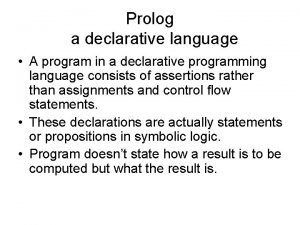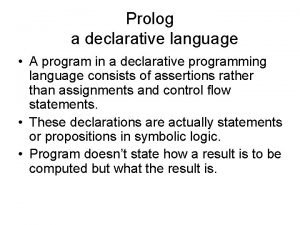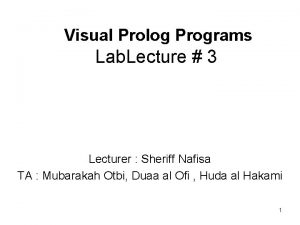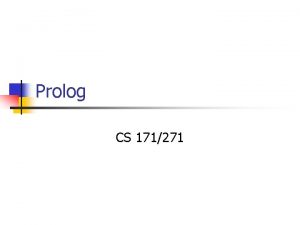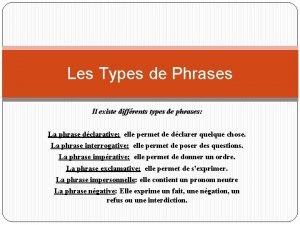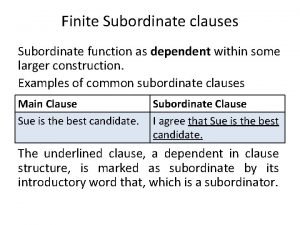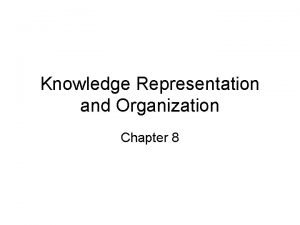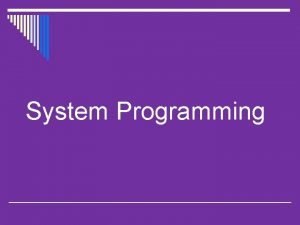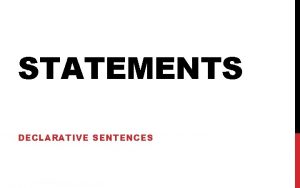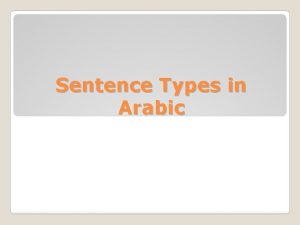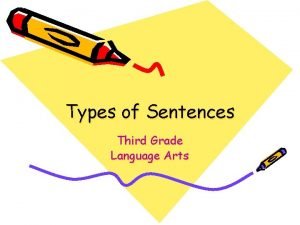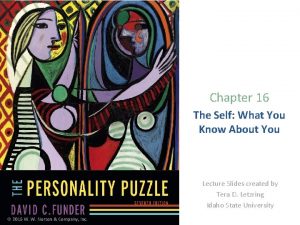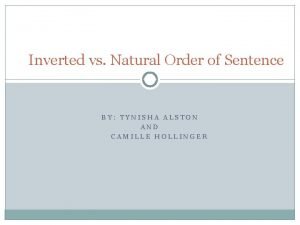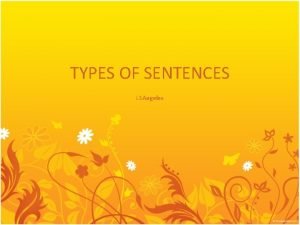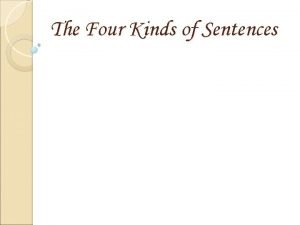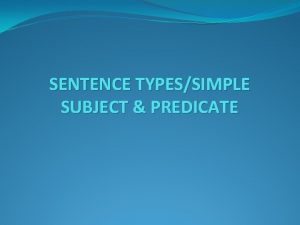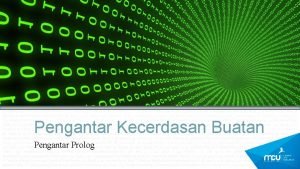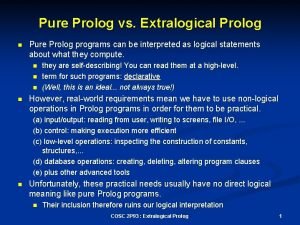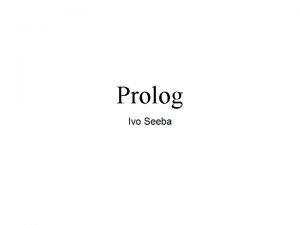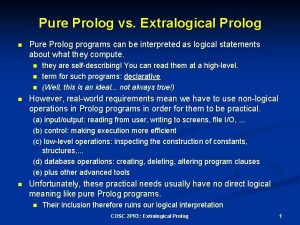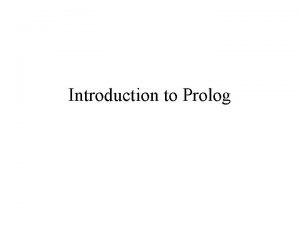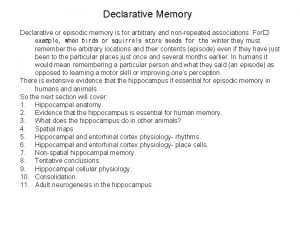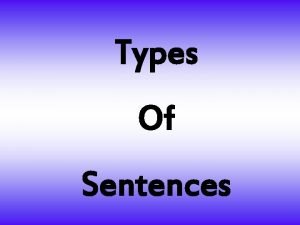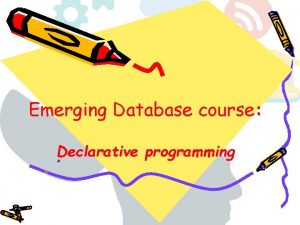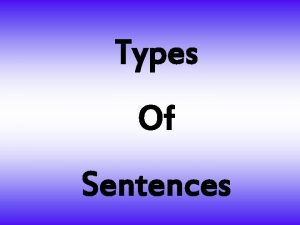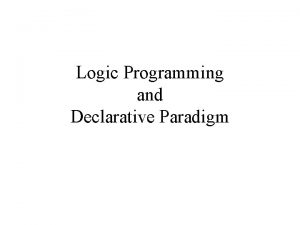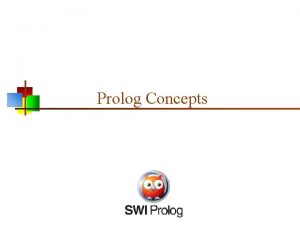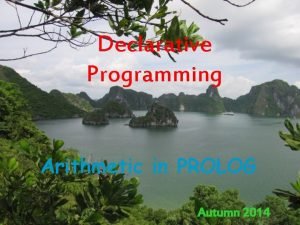PROLOG What is PROLOG Prolog is a Declarative













![• • ? - [1, 2, 3, 4, 5] = [Head | Tail]. • • ? - [1, 2, 3, 4, 5] = [Head | Tail].](https://slidetodoc.com/presentation_image_h/16b0e087d0fbdeece399d3b1dde55dab/image-14.jpg)
![• ? - concat_lists([1, 2, 3], [a, b, c, d], X) • X • ? - concat_lists([1, 2, 3], [a, b, c, d], X) • X](https://slidetodoc.com/presentation_image_h/16b0e087d0fbdeece399d3b1dde55dab/image-15.jpg)

![• • ? - analyse_list([dog, cat, horse, cow]) This is the head of • • ? - analyse_list([dog, cat, horse, cow]) This is the head of](https://slidetodoc.com/presentation_image_h/16b0e087d0fbdeece399d3b1dde55dab/image-17.jpg)
![• • • ? - reverse_list([lion, elephant, monkey], List) List = [monkey, elephant, • • • ? - reverse_list([lion, elephant, monkey], List) List = [monkey, elephant,](https://slidetodoc.com/presentation_image_h/16b0e087d0fbdeece399d3b1dde55dab/image-18.jpg)




- Slides: 22

PROLOG

What is PROLOG? • Prolog is a Declarative or logical Language. • Prolog takes only facts and rules to arrive at goals. • The programmer doesn’t tell it how to solve. • For solving logic and decision problems, Prolog is ideal. • Typical applications: AI, Database apps, proving theorems, symbolic evaluation (i. e. differentiation).

How does Prolog work ? • Prolog is based on ‘Horn Clauses’ • Horn Clauses are a subset of ‘Predicate Logic’ • Predicate logic is a way of simply defining how reasoning gets done in logic terms. • Predicate Logic is a syntax for easily reading and writing Logical ideas.

Predicate Logic • To transform an English sentence to Predicate Logic, we remove unnecessary terms. • This leaves only the relationship and the entities involved, known as arguments. • Ex: A pie is good = good(pie) • The relation is ‘good’, the relation’s argument is ‘pie’. • In Prolog, we call the relation’s name (e. g. “good”) the ‘Functor’. A relation may include many arguments after the functor.

Components of Prolog • Facts and rules are the two important components in prolog.

Facts • Facts have simple syntax and it always begin with lowercase letter. • Eg : • smaller(ant, grasshopper). • smaller(ant, ladybird). • smaller(ladybird, grasshopper). • These facts are also known as clauses.

• After compilation of the facts if we query the prolog system : • ? - smaller(ant, ladybird). • Yes. • ? - smaller(grasshopper, ladybird). • No.

Rules • Any conditional statement about the world are stated rules in prolog. • For representing rules : - symbol is used. • Syntax of rule : • Head : - body pattern • Head is true if body is true.

• • fly(x) : - bird(x) bird(dove). ? -fly(A) A = dove

Prolog syntax • 1. Atoms : are sting of lowercase and uppercase letter, digits, underscore. • 2. Numbers : integers, floats • 3. Variables : are string of lowercase and uppercase letter, digits, underscore. • 4. Compound terms : consists of prolog atoms ‘functor’. Is_bigger(tiger, X)

Built-in Predicates • • ? - X=tiger, write(X), n 1. Tiger. X=Tiger. Yes.

Matching • • • ? - is_bigger(X, cat) = is_bigger(tiger, cat). X=tiger Yes ? - p(_, 2, 2) = p(1, Y, _) Y=2 Yes

List Manipulation • • List uses collection of terms. List is denoted by square brackets []. [] means an empty list. The first element of the list is called head and remaining is called tail.
![1 2 3 4 5 Head Tail • • ? - [1, 2, 3, 4, 5] = [Head | Tail].](https://slidetodoc.com/presentation_image_h/16b0e087d0fbdeece399d3b1dde55dab/image-14.jpg)
• • ? - [1, 2, 3, 4, 5] = [Head | Tail]. Head = 1 Tail = [2, 3, 4, 5] Yes ? - [q, l, j, j, l, b] = [__, X | __] X=l Yes
![concatlists1 2 3 a b c d X X • ? - concat_lists([1, 2, 3], [a, b, c, d], X) • X](https://slidetodoc.com/presentation_image_h/16b0e087d0fbdeece399d3b1dde55dab/image-15.jpg)
• ? - concat_lists([1, 2, 3], [a, b, c, d], X) • X = [1, 2, 3, a, b, c, d] • Yes

Built-in predicates in list • • ? – length(List, 3) List = [A 1, A 2, A 3] Yes ? – member(cat, [horse, donkey, cat, monkey]) Yes ? - analyse_list([]) This is an empty list. Yes
![analyselistdog cat horse cow This is the head of • • ? - analyse_list([dog, cat, horse, cow]) This is the head of](https://slidetodoc.com/presentation_image_h/16b0e087d0fbdeece399d3b1dde55dab/image-17.jpg)
• • ? - analyse_list([dog, cat, horse, cow]) This is the head of your list : dog This is the tail of your list : [cat, horse, cow] Yes ? - remove_duplicates([a, b, a, c, d, d], List). List = [b, a, c, d] Yes
![reverselistlion elephant monkey List List monkey elephant • • • ? - reverse_list([lion, elephant, monkey], List) List = [monkey, elephant,](https://slidetodoc.com/presentation_image_h/16b0e087d0fbdeece399d3b1dde55dab/image-18.jpg)
• • • ? - reverse_list([lion, elephant, monkey], List) List = [monkey, elephant, lion] Yes ? - replace([1, 2, 3, 4, 3, 5], 3, x, List). List = [1, 2, x, 4, x, 5] Yes

Arithmetic operations in prolog • • • ? - X is 3 + 5 , X = 8 X=8 Yes ? - 8 is 3 + 5 Yes

Functions in prolog • • Max Min Sqrt abs

relations • • >= <= == (not equal) =: = (equal)

structure • • • Stores in form of record. bookdetails(title, AI, publisher, spd). Query : ? - bookdetails(title, _, publisher, _) AI spd Yes
 Prolog is a declarative language
Prolog is a declarative language Prolog is a declarative language
Prolog is a declarative language Visual studio prolog
Visual studio prolog Download prolog
Download prolog Phrase declarative
Phrase declarative Main clause vs subordinate clause
Main clause vs subordinate clause Imperative declarative exclamatory interrogative
Imperative declarative exclamatory interrogative Evolve knowledge
Evolve knowledge What is imperative statement in assembly language
What is imperative statement in assembly language Predicate pronoun sentences
Predicate pronoun sentences Compare procedural semantics and declarative semantics.
Compare procedural semantics and declarative semantics. Topic sentence in arabic
Topic sentence in arabic Declarative sentence
Declarative sentence Declarative routing
Declarative routing Procedural self-knowledge does not include ________.
Procedural self-knowledge does not include ________. Natural order of a sentence
Natural order of a sentence 5 example of declarative sentence
5 example of declarative sentence Declarative interrogative imperative exclamatory sentences
Declarative interrogative imperative exclamatory sentences Declarative hypothesis
Declarative hypothesis Exclamatory sentence
Exclamatory sentence Declarative memory
Declarative memory Simple subject example
Simple subject example Types of knowledge
Types of knowledge
